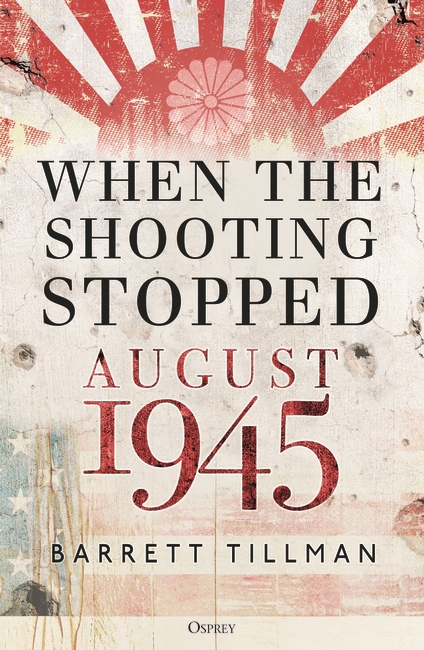
August 1945 was The Month That Changed the World. With Japan’s acceptance of the Allies’ Potsdam Declaration, the six-year conflagration that seared three continents came to an end. Historians continually recompute the lives lost, now reckoned upwards of 80 million – approximately 3 percent of earth’s population.
The end of World War II also heralded the end of the colonial era. Imperial Japan and Nazi Germany lost their conquests immediately, and Great Britain, France, Belgium and others would also eventually lose their far-flung possessions. Nations that had lived under foreign rule for generations began a slide into national independence, notably in India, Indonesia, and Vietnam.
At the same time, VJ Day began the Cold War with Winston Churchill’s description of the Soviet Union’s Iron Curtain. Thus, August 1945 set the stage for global confrontations over the next four decades, with geopolitical fault lines still remaining.
When the Shooting Stopped reminds us that history is a journey rather than a destination. It began with a 1990 magazine article, “The Day the Shooting Stopped,” describing US Navy combat on the last day of hostilities, August 15, 1945 (Western Pacific date). Subsequently I built on that foundation, expanding coverage to the entire month.
The cast was large and varied, from national leaders Truman, Churchill, Stalin, Gandhi, and Hirohito to US, British, Soviet, and Japanese sailors and fliers at the sharp end of combat. Also included are voices from the thousands of prisoners of war and detainees facing an uncertain future, often overlooked in broader studies.
The VJ period offers authors scenarios rich in variety. Aside from the two atom bombs and US–UK fleet operations, conflict spread on the Asian mainland. Nationalist and Communist Chinese forces fought the Japanese, setting the stage for the four-year civil war. Meanwhile, Russia launched a massive offensive into Japanese-held Manchuria on the same day that Hiroshima was bombed. It was the third time Tokyo and Moscow had crossed swords, breaking the “tie” of Japan’s victory in 1905 and the USSR’s in 1939.
Aircrew and sailors in the Western Pacific were caught in a time warp on the morning of August 15. Hundreds of B-29 bombers were returning from their nocturnal missions over Japan when crews heard the radio announcement of Tokyo’s surrender. At the same time, carrier airmen were inbound to targets when they were belatedly recalled.
I knew naval aviators who flew that morning, and some were caught between Tokyo’s announcement and the broadcast to Allied forces in the Asia–Pacific realm. As one later wrote, “It brought all the joy and unreasoning happiness that we would live and not die.”
However, some did die, either in belated combats or murdered by vengeful captors. Those tragedies are also a part of When the Shooting Stopped.
The official end of the war came two weeks later when Japanese and Allied officials signed the documents aboard the battleship Missouri in Tokyo Harbor on September 2.
Only one veteran contributor to the book is still alive today, just three years after publication. He’s a 103-year-old Hellcat ace who got waylaid while driving through Louisiana en route to his new duty station in Florida. The local residents celebrated the news and offered their hospitality, even providing gasoline free of charge.
Civilian accounts of VJ Day are part of the story as well. They range from horror at the irradiated rubble of Hiroshima and Nagasaki to joyous outpourings around the world, most notably the huge gathering in New York’s Times Square with the iconic image of “the kiss” that continues to resonate eight decades later. But often overlooked are Western internees in Japanese captivity from the Home Islands to China and the Dutch East Indies. When the Shooting Stopped provides first-person perspectives on all those and more.
Among American civilians I recalled a long-ago account from my mother, who in 1945 was an Oregon rodeo princess. She saw the exuberance of Navy pilots violating a variety of regulations, then partying without concern for officialdom.
Despite the passage of 80 years, there are still lessons to be learned from August 1945 and how they apply to our present world.
Most of the controversy over Japan’s unconditional surrender and the atomic bombs occurred in an information vacuum for decades. With declassification of diplomatic and military documents, a far greater understanding of the US and Allied decision-making process is possible, and this is explained in When the Shooting Stopped.
Whatever the era, living history has a shelf life. Anyone interested in a particular period can benefit future historians by interviewing and recording the experiences of those who lived the events. Do it now.
“The Greatest Generation” mantra has become reflexive since Tom Brokaw’s 1998 book of the same name. But When the Shooting Stopped objectively examines World War II in the context of previous generations, especially America’s founders, who faced immensely greater challenges. Nevertheless, “the VJ generation” returned dozens of countries to their rightful owners, and that in itself was “great.”
You can read more in When the Shooting Stopped: August 1945.

Comments
You must be logged in to comment on this post. Click here to log in.
Submit your comment